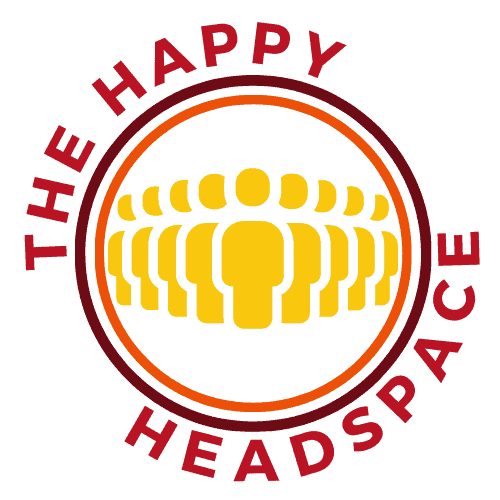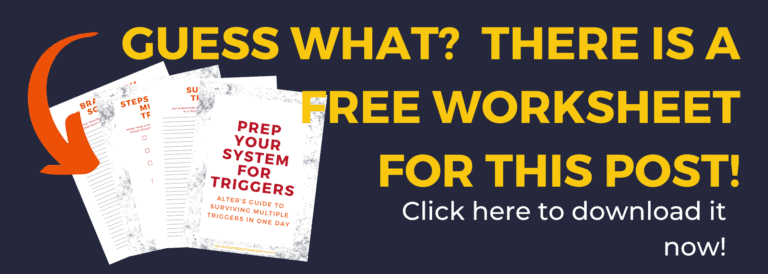When you have Dissociative Identity Disorder, eventually you’re going to have a day where your body faces multiple triggers in a single day. When that happens, it can be very overwhelming trying to figure out what to do first. This guide will work you through a practice example so that your system can face any day like a champ! Let’s jump right in!
Table of Contents
WARNING AND DISCLAIMER
Because of the nature of D.I.D., it’s possible that something in this article could be triggering to your system. Please use caution and your best judgement when reading this article. Safety first!
Disclaimer: We are not doctors, therapists, or mental health professionals. We’re just a bunch of alters that are speaking from personal experience to help other systems live their best lives.
Six Steps To Facing Multiple Triggers In One Day
Facing a day with lots of triggers can be daunting but it doesn’t have to be! There are six key steps to planning out what your system can do when you know that you’ll be facing multiple triggers in one day. When your system works through these steps, the whole situation becomes much, much easier to handle. These are the steps:
- One: List all suspected triggers for that day
- Two: Cross off anything that your system can not control
- Three: Brainstorm how to reduce the triggers your system CAN control
- Four: Determine how frequently you’ll come in contact with the uncontrollable triggers
- Five: Create a plan to reduce sensitivity to the most frequent trigger your system can’t control
- Six: Assign alters to front with the uncontrollable triggers
Example Of The Six Steps To Facing Multiple Triggers In One Day
Now that you know the six steps to prepare your system for a day with multiple triggers, we’re going to walk you through an example that happened to us. Every system is unique so your system’s solutions may look a little different. That’s ok! These six steps will help your system find clarity amongst all of the confusion.
One: List All Suspected Triggers For That Day
Our example takes place at the end of August when our daughter was starting kindergarten. Our system typically dislikes being around schools, buses, medical masks, and anything having to do with cars. Now that our daughter has started school, this is a nine month long reality for us so we need to be prepared. We made a list of all the things surrounding school that are triggering for us:
- Schools
- School buses
- Masks
- Clusters of children standing together
- Driving
- Driving near pedestrians
- Time crunches
Two: Cross Off Anything That Your System Can Not Control
We went through the list as a system and crossed off anything that is outside of our control.
Schools (We could technically homeschool her but that’s not realistic right now)School buses (There will always be school buses)Masks (Those are going to be here for awhile)Clusters of children standing together (Kids are going to be kids)- Driving (Can work on trading with a family member; can also find a less busy route)
- Driving near pedestrians (Can dramatically reduce this by going as early as possible)
- Time crunches (Can do as much as possible in advance)
Three: Brainstorm How To Reduce The Triggers Your System CAN Control
When we did this, we were left with three options for reducing stress for ourselves. We used this as a framework to create a better system for avoiding triggers:
- Driving: On Mondays and Fridays, our husband’s work schedule allows him to drive her to school. We traded doing one or two of his morning chores in exchange for him driving her to school on the days he’s able to.
- Driving near pedestrians: By getting to the school as early as possible, there is practically no one there. Win win because out daughter loves getting extra time to socialize.
- Time crunches: We spent about an hour bundling up our daughter’s outfits for the month. Each bundle has everything from hair bows to socks. Just grab a bundle and go. Also taught our daughter how to prepack her lunchbox and backpack right when she comes home from school. We’re able to finish everything before we go to sleep. We moved our shower time to be after we get home from dropping her off at school. Now we don’t have to worry about accidental time loss in the shower.
This significantly helped us to feel more confident and in control! By making these simple tweaks, my system was able to remove several triggers pretty easily. We also felt very empowered seeing how much we WERE able to control about our circumstances. Knowing that there are things that we can improve made our whole system feel emotionally ready for step four.
Four: Determine How Frequently You’ll Come In Contact With The Uncontrollable Triggers
To even things out further, we took the things that we can’t control and tried to see just how often we will actually come in contact with them.
- Schools (No one is allowed in the school and the inside is where most of our triggers come from.)
- School buses (These drive by my house multiple times a day, I see them at the school, and I see them while out and about.)
- Masks (Who knows how long this will last. We’re starting to become desensitized to them, especially if they’re the fabric kind.)
- Clusters of children stranding together (Very rarely, if ever, if we keep dropping our daughter off early. We’ll probably be too busy to notice and, even if we do see this, they’ll be far away from us.)
Now our system had an idea of how frequently each of these triggers would realistically be in contact with us. Seeing this helped our system to feel more calm knowing that some of these triggers will not be happening often. For the more common triggers, our system had a clear cut idea of what will realistically happen.
Five: Create A Plan To Reduce Sensitivity To The Most Frequent Trigger Your System Can’t Control
After we evaluated how often we’d come in contact with each trigger that we can’t control, we were able to clearly see which trigger we’d encounter most. We saw that our system would be best off if we worked on our fear of buses followed by our fear of masks. That would give us the most bang for our buck.
We used this information to use journaling, therapy, and exposure therapy to reduce our system’s sensitivity to our biggest trigger.
Six: Assign Alter To Front With The Uncontrollable Triggers
Now that we had a plan for how to reduce our sensitivity to triggers outside of our control, we were able to pick alters to front when those triggers did come up. Knowing that we had a plan for facing triggers made our whole system feel so much better about facing days packed with potential triggers.
What Next?
Now that your system has the tools to face multiple triggers in one day, what else can you do? If your system needs to prepare for the holidays, you can read more here. (This article here deals specifically with Halloween!) If your system is ready to work on becoming more united, learning how to take care of alters inside and outside of the headspace, and all around working as a focused team, check out our course, Of One Mind!

